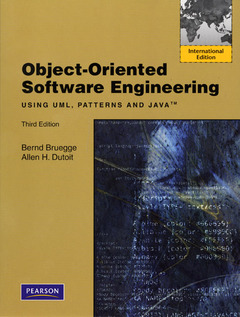Object oriented software engineering using UML, Patterns and Java (International Ed.) (3rd Ed.)
Auteurs : BRUEGGE Bernd, DUTOIT Allen H.

For courses in Software Engineering, Software Development, or Object-Oriented Design and Analysis at the Junior/Senior or Graduate level. This text can also be utilized in short technical courses or in short, intensive management courses.
Object-Oriented Software Engineering Using UML, Patterns, and Java, 3e, shows readers how to use both the principles of software engineering and the practices of various object-oriented tools, processes, and products.
Using a step-by-step case study to illustrate the concepts and topics in each chapter, Bruegge and Dutoit emphasize learning object-oriented software engineer through practical experience: readers can apply the techniques learned in class by implementing a real-world software project.
The third edition addresses new trends, in particular agile project management (Chapter 14 Project Management) and agile methodologies (Chapter 16 Methodologies).
Foreword
Preface
Acknowledgments
PART I Getting Started
Chapter 1 Introduction to Software Engineering
1.1 Introduction: Software Engineering Failures
1.2 What Is Software Engineering?
1.2.1 Modeling
1.2.2 Problem Solving
1.2.3 Knowledge Acquisition
1.2.4 Rationale
1.3 Software Engineering Concepts 1
1.3.1 Participants and Roles
1.3.2 Systems and Models
1.3.3 Work Products
1.3.4 Activities, Tasks, and Resources
1.3.5 Functional and Nonfunctional Requirements
1.3.6 Notations, Methods, and Methodologies
1.4 Software Engineering Development Activities
1.4.1 Requirements Elicitation
1.4.2 Analysis
1.4.3 System Design
1.4.4 Object Design
1.4.5 Implementation
1.4.6 Testing
1.5 Managing Software Development
1.5.1 Communication
1.5.2 Rationale Management
1.5.3 Software Configuration Management
1.5.4 Project Management
1.5.5 Software Life Cycle
1.5.6 Putting It All Together
1.6 ARENA Case Study
1.7 Further Reading
1.8 Exercises
Chapter 2 Modeling with UML
2.1 Introduction
2.2 An Overview of UML
2.2.1 Use Case Diagrams
2.2.2 Class Diagrams
2.2.3 Interaction Diagrams
2.2.4 State Machine Diagrams
2.2.5 Activity Diagrams
2.3 Modeling Concepts
2.3.1 Systems, Models, and Views
2.3.2 Data Types, Abstract Data Types, and Instances
2.3.3 Classes, Abstract Classes, and Objects
2.3.4 Event Classes, Events, and Messages
2.3.5 Object-Oriented Modeling
2.3.6 Falsification and Prototyping
2.4 A Deeper View into UML
Date de parution : 08-2009
Ouvrage de 512 p.
17.8x23.5 cm



